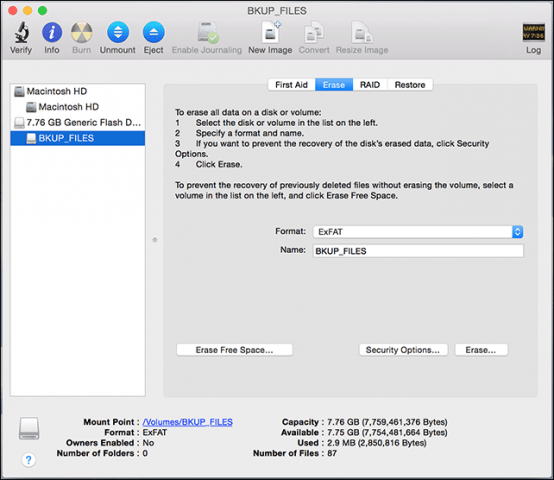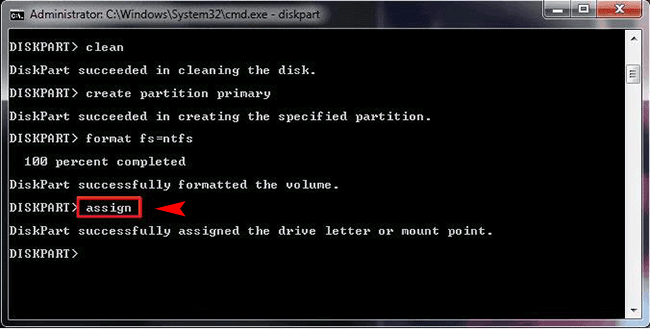To format a drive on a Mac, you’ll need the built-in Disk Utility application. Press Command+Space to open the Spotlight search dialog, type “Disk Utility”, and press “Enter” to launch the app. You can also open a Finder window, select “Applications” in the sidebar, and head to Utilities Disk Utility. To format your USB drive on Mac, enter the following command: sudo diskutil eraseDisk FORMAT VOLUME-NAME USB-LOCATION-AND-NAME Where: FORMAT is where you choose which format you want to use when erasing and formatting your pen drive. There are many file types available when you format a USB drive on Mac, such as exFAT, FAT32, JHFS+, etc. How to Format USB Drive in Windows or Mac. After choosing the best format for USB drive according to your needs, you might start to wonder: how do I format USB drive to NTFS/FAT32/exFAT/EXT 2,3,4/HFS+ in Windows operating system or Mac? Well, don't worry. If you need to format USB drive to NTFS/FAT32/exFAT/EXT 2,3,4/HFS+ file system, please.

Formatting a USB drive in Ubuntu using Terminal commands is much easier as formatting it in Windows systems. Some of the Ubuntu users are not familiar with terminal commands. This tutorial will help Ubuntu (Linux) users with the simple steps of USB flash drive formatting via command line. Step 1 – Attach USB to System. The procedure will be as follows: Run the command prompt as administrator (see How to start the command prompt as administrator) and enter the command (an. Format d: / fs: fat32 / q (In this command, after fs: you can specify NTFS to format not in FAT32, but in NTFS.
Format External Hard Drive Mac
How to format and create a USB drive or pen drive that is compatible with Windows 10, 8, 7 or Mac or Linux.
A file system is a method and structure of data used by an operating system, called Windows, Linux or Mac OS, for reading media files such as disks, removable drives, etc.
Types of File Systems
It is vital that we are aware that each developer implements a series of file systems for their operating system, for example, we have the following:
Windows:
- FAT
- FAT32
- NTFS
- exFAT
Linux:
- ext2
- ext3
- ext4
- ReiserFS
- Swap
Mac OS:
- HFS +
- MS-DOS (FAT)
- exFAT
- APFS (Present in the new edition of macOS High Sierra)
Each system manages its file system and in this way, USB drive with NTFS can only be recognized in Windows environments but not in Linux or macOS environments, even if it is accepted in macOS we can not make changes to it.
At this point, another question arises, what type of file system to use that is compatible with these three operating systems?
In technical terms, it has been recommended that the file system of the USB drives be FAT32 thanks to the fact that it is an old file system and that it has evolved to FAT32 at present, but there is a format that is much better regarding security, reliability, and compatibility: exFAT.
Let’s see in detail what is and what covers each of these file systems.
FAT32:
This format is one of the most compatible, but due to its useful life, it has been in force since the 90s, it has a series of limitations that can affect the pace of updates we are experiencing today.
Being a format with so much active time is compatible with virtually any operating system.
As mentioned, it has its limitations such as the inability to host files larger than 4 GB or that partitions with this file system cannot have more than 8 TB capacity.
exFAT:
exFAT is in a way a more modern and dynamic FAT32 which was developed in 2006 and is present in most modern operating systems.
By default, all traditional operating systems, Windows, Linux or Mac OS are compatible with exFAT, and its use is highly recommended for external drives, such as USB devices or external drives, thanks to its simplicity and multiple features.
Now we will analyze a little more in detail the fields of action where these two file systems are compatible to know which is the best option to choose.

Device Support

This is the first fundamental field since if the USB device formatted with FAT23 or exFAT is not compatible with the device where it has to be connected it will be impossible for it to be recognized and to access its contents.
In this field, we can say that FAT32 has an advantage over exFAT because, being an old file system, it is compatible with all operating systems and devices such as game consoles, Smart TV, multimedia players and others.
ExFAT, although it is currently compatible with more than 95% of the devices on the market, can still find individual limitations in some Linux distros or Android devices.
In some Linux distros the exFAT file system will not be recognized immediately, so we must install the several utilities by executing the following line:
Then update the packages running the line:
Reading & Writing Speed
Another of the pillars in a file system is the ability with which this can access the content and read or write it since this depends on optimal performance which is a highly required value today. Undoubtedly in this regard exFAT outperforms FAT32 to be a much more recent technology which is compatible with USB 3.0 which can have a transfer rate up to 5 Gbps.
In the previous graphic of flexense we can see the performance of exFAT on FAT32, and in the following link we will be able to look in detail multiple operations carried out by this software developer called Flexsense
Size of Supported Files
Undoubtedly on this field wins exFAT because, as we mentioned above, FAT32 only allows files with a maximum capacity of 4 GB in partitions that do not exceed 8 TB of storage while exFAT is virtually unlimited in this aspect to support 16ZB files.
How To Format a USB drive with exFAT
Starting from the detail that exFAT is the most practical and functional file system, unless we are not going to use files of more than 4 GB, this is the process of formatting the USB drives with exFAT.
It will first be necessary to install the exFAT tools by executing the following command, as we have mentioned before:
Later we run the fdisk -l line to list the active disks in the system.
There we will locate the USB drive which has the extension /dev/sd** (Replace the ** with the indicated number)
Once the USB disk is identified, we will execute the following syntax:
As we understand, we have the freedom to select the best file system for our USB drives to have the best capacity and performance.
Making things happen without any third party tools is joyful. In this article, I’d like to show how to make a bootable USB simply using built-in commands in a terminal on macOS.
1. Prepare Everything Needed
What you need:
A Ubuntu installer ISO file, you can download from either site below:
A Flash Drive that is free to use.
2. Clear up your USB Flash Drive (Optional)
2.1. Locate your USB disk
- List the partition of the disk:
- Then find your usb disk info as below:
2.2. Erase the disk
Erasing disks from the command-line can be a dangerous process as there aren’t any warnings or confirmations. One typo could lead to irreversible data loss if there’s no backup to restore from. If you’re not familiar with the command-line, Disk Utility is just as capable.
To erase an entire disk:
Erasing a whole disk will clear any partitions and create a new, single partition, before formatting it as a volume.
{filesystem}:You can specify the filesystem to format the partition in by using any that are supported. To find out which filesystems you can use, enter:
And you may get this:
{Name_to_use}:This simply refers to the name of the volume that will be created. In this instance, I’ve just labelled the volume as “Test”.
{disk_identifier}:Only the primary part of the identifier (i.e.
disk1,disk2,disk3…) is needed.
Format Thumb Drive Mac Command Line Windows 10
In my case, the actual command I used to erase the USB disk is
If sucessful, it will show information like this:
Meanwhile the USB is automatically mounted to you system as well. In my case, it’s mounted at /Volumes/KF-USB.
Now use command diskutil list again to show the disk partition information, you’ll see the new disk’s info:
3. Create the Bootable USB
Assuming our flash drive is stll disk2, then
The unmountDisk command unmounts all volumes of the given disk drive but keeps the drive itself visible to the computer (as opposed to the eject option that disconnects it entirely)
Then, run the following command to create the bootable USB:
“sudo” tells the system to use root level (that is the system’s highest level) privileges to perform the following action.
“dd” is an extremely basic, but powerful block level copy command built into all Linux and Unix operating systems (MacOS is UNIX based)
“if” stands for input file (a.k.a the source file or location). In our use-case, this is the .ISO file. In MacOS, if you have a finder window open, you can drag and drop the .iso into the terminal and it will auto-fill this file path.

Format Thumb Drive Bootable
“of” stands for “output file” (a.k.a the destination file or location). For us, this is our USB drive, disk2. The specific path for external drives is in “/dev”, hence /dev/disk2
“bs” stands for block size. dd copies data in blocks rather than on a file by file basis (this is why it’s so fast) and this command gives you the option to set how big each block is. There is a science to the ideal block size, but I don’t know it. 8m (MegaBytes) has consistently worked well for my uses.
The command will not show any progress until it’s done, but you can press control+t for status updates. With an average computer, this takes less than 5min to complete.Once complete:
The USB drive can now safely be removed. Assuming that the iso is EFI-compatible, you can reboot your mac to test it.
Reformat Thumb Drive Mac
KF
